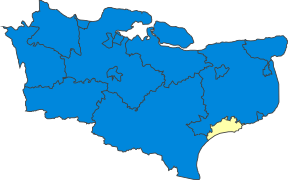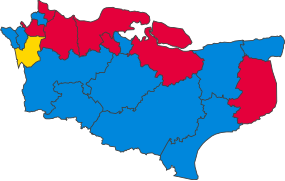|
Parliamentary constituencies in Kent
The ceremonial county of Kent, (which includes the unitary authority of Medway), is divided into 18 parliamentary constituencies - 2 borough constituency and 16 county constituencies. ConstituenciesConservative † Labour ‡ Liberal Democrats ¤ Reform Boundary changes2024See 2023 Periodic Review of Westminster constituencies for further details.
For the 2023 Periodic Review of Westminster constituencies, which redrew the constituency map ahead of the 2024 United Kingdom general election, the Boundary Commission for England created an additional seat in created in Kent to reflect the growth of its electorate, with the formation of the constituency of Weald of Kent. As a consequence, Maidstone and the Weald, and Tonbridge and Malling were renamed Maidstone and Malling, and Tonbridge respectively. Changes to North Thanet and South Thanet resulted in them being renamed Herne Bay and Sandwich, and Thanet East respectively. Although only subject to a very minor boundary change, Dover reverted to its previous name of Dover and Deal.[2][3][4] The following constituencies resulted from the boundary review: Containing electoral wards from Ashford
Containing electoral wards from Canterbury
Containing electoral wards from Dartford Containing electoral wards from Dover
Containing electoral wards from Folkestone and Hythe
Containing electoral wards from Gravesham Containing electoral wards from Maidstone
Containing electoral wards from Medway Containing electoral wards from Sevenoaks
Containing electoral wards from Swale
Containing electoral wards from Thanet
Containing electoral wards from Tonbridge and Malling
Containing electoral wards from Tunbridge Wells
2010Under the Fifth Periodic Review of Westminster constituencies, the Boundary Commission for England[5] decided to retain Kent's 17 constituencies for the 2010 election, making minor changes to realign constituency boundaries with the boundaries of current local government wards, and to reduce the electoral disparity between constituencies, including the transfer of Cliftonville from North Thanet to South Thanet. They recommended two name changes: Gillingham to Gillingham and Rainham to reflect the similar stature of the two towns, and Medway to Rochester and Strood to avoid confusion with the larger Medway unitary authority.
1997Under the Fourth Periodic Review of Westminster constituencies, the Boundary Commission for England opted to increase the number of constituencies in Kent from 16 to 17, reflecting the growth of the county's electorate. The "new" constituency, i.e. the constituency that did not contain a majority of any previous constituency's electorate, was Faversham & Mid Kent, which was formed from portions of the previous Maidstone, Faversham, Mid Kent and Canterbury constituencies. This had knock-on effects throughout the county, and resulted in the renaming of the former constituencies of Faversham and Mid Kent to Sittingbourne & Sheppey and Chatham & Aylesford, respectively.[6][7]
1983Under the Third Periodic Review of Westminster constituencies, the Boundary Commission for England opted to increase the number of constituencies in Kent from 15 to 16, reflecting the growth of the county's electorate. This resulted in the previously oversized Rochester and Chatham being split in half, with the city of Rochester becoming part of the new seat of Medway, along with the rural Hoo Peninsula (previously part of the Gravesend constituency) while town of Chatham became part of the new seat of Mid Kent, along with the northern portion of Maidstone. Thanet East (renamed North Thanet) and Thanet West (renamed South Thanet) gained parts of Canterbury and Dover and Deal (renamed Dover) respectively. Small transfer from Sevenoaks to Dartford to make their electorates more equal and minor or no changes to Ashford, Faversham, Folkestone and Hythe, Gillingham, Tonbridge and Malling, and Tunbridge Wells.[8][9]
Results historyPrimary data source: House of Commons research briefing - General election results from 1918 to 2019[10] 2024The number of votes cast for each political party who fielded candidates in constituencies comprising Kent in the 2019 general election were as follows:
Percentage votes
12019 - Brexit Party * Included in Other Seats
Maps1885-1910
1918-1945
1950-1970
1974-present
Historic representation by partyA cell marked → (with a different colour background to the preceding cell) indicates that the previous MP continued to sit under a new party name. 1885 to 1918Conservative Independent Conservative Independent Liberal Labour Liberal Liberal Unionist National Party
1918 to 1950Coalition Liberal (1918-22) / National Liberal (1922-23) Conservative Constitutionalist Independent Labour Liberal National Labour
1950 to 1974
1974 to 2010Conservative Independent Labour
2010 to presentConservative Independent Labour Liberal Democrats UKIP
See alsoNotesReferences
|
|||||||||||||||||||||||||||||||||||||||||||||||||||||||||||||||||||||||||||||||||||||||||||||||||||||||||||||||||||||||||||||||||||||||||||||||||||||||||||||||||||||||||||||||||||||||||||||||||||||||||||||||||||||||||||||||||||||||||||||||||||||||||||||||||||||||||||||||||||||||||||||||||||||||||||||||||||||||||||||||||||||||||||||||||||||||||||||||||||||||||||||||||||||||||||||||||||||||||||||||||||||||||||||||||||||||||||||||||||||||||||||||||||||||||||||||||||||||||||||||||||||||||||||||||||||||||||||||||||||||||||||||||||||||||||||||||||||||||||||||||||||||||||||||||||||||||||||||||||||||||||||||||||||||||||||||||||||||||||||||||||||||||||||||||||||||||||||||||||||||||||||||||||||||||||||||||||||||||||||||||||||||||||||||||||||||||||||||||||||||||||||||||||||||||||||||||||||||||||||||||||||||||||||||||||||||||||||||||||||||||||||||||||||||||||||||||||||||||||||||||||||||||||||||||||||||||||||||||||||||||||||||||||||||||||||||||||||||||||||||||||||||||||||||||||||||||||||||||||||||
Portal di Ensiklopedia Dunia

















































